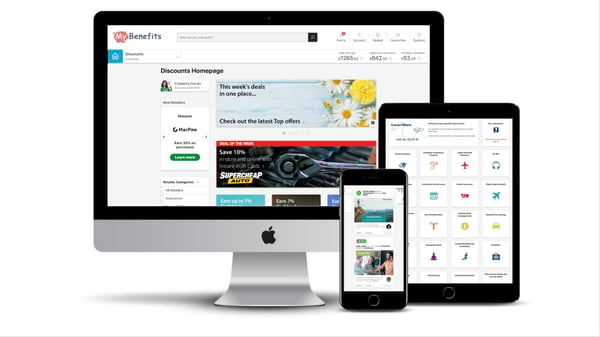Last month, Joel Rethore, Group Head of Rewards, Performance & People Analytics at Healius, joined Reward Gateway for a live chat about how leading companies are evolving their benefits strategy to meet the needs of a modern workforce.
With a team of over 12,000 healthcare professionals providing services in medical centres, pathology labs and diagnostic imaging sites Australia-wide, Joel’s team is well versed in dealing with an increasingly dispersed, diverse and digital work environment.
We discussed how Healius designed a benefits offering that centres on providing employees choice, relevance and a more user-friendly experience. Here's a snapshot from our conversation.
Q: How did you start building the benefits strategy at Healius, and ensure it caters for such a diverse workforce?
Joel: I’d start by saying that it's not so much about what you do, but it's more about why you do it, and how you do it. Looking at the Latin origin of the word “benefits”, it’s interesting to see that it originally comes from two words - “bene” and “fit." “Fit” is the origin of the word “factory.” So really “benefits” are the factory of good things.
So we started the journey remembering that what we are trying to do is something that is good for our people, so that they can take advantage of working at Healius.
Q: Tell us about some of the challenges you have faced when designing a benefits offering for such a large group of people?
Joel: At Healius we have 12,000 people located all across the country, including people working in remote locations and in various jobs – from collectors, doctors, and nurses to imaging specialists and people working in our offices. Right from the start, we know that we cannot meet all of their needs.
To appeal to them we needed to start with a common denominator. Modern employee benefits are designed around what people need and make it easy for them to access. That was one of the reasons we partnered with Reward Gateway – we knew it was a benefit all of our people could use.
To begin with, it really was about bridging the gap. There’s the gap between employees and employers; a report by Willis Towers Watson showed that while 67% of employers think they have a comprehensive benefits offering that their employees value, less than half of their employees actually agree that their current benefits meet their needs.
Employers that do a better job at having the right benefits to generate highly engaged employees also generate about 20% more shareholder return.
That gap between the employer’s perception and the employee reality is a big opportunity. My view is that having the right benefits is also a way to generate value for the company.

Q: What are some of the key things HR leaders should consider when thinking about evolving their benefits strategy or investing in an employee benefits platform?
If you’re thinking about it as an investment, you have to think about your return on investment. There are few things to consider in this:
- The first is transactional return. For us, the amount of money we spend on the platform is less than the amount of money we help our employees save for themselves. That’s simple, transactional ROI.
- Second is the cost of the platform versus the time saved in administration and communication. In our experience, administering our benefits platform is less than 5% of one headcount. The person managing the platform is enjoying it so much because it's become part of personal development journey as well; we now have a tool that will empower us with data to inform her decisions. The tool also allows us to reach our people directly and communicate about our benefits to our very widespread workforce in Australia. So while a benefits platform comes at a cost, having it enables and empowers us more.
- Finally, consider the experience for your employees. If they’re on the bus and they access their benefits, we as a business are connecting with them in that moment in a way that their manager can’t, because their manager isn’t sitting there next to them. But we’re giving them something tangible and real. That fits nicely into our larger suite of benefits; we've got skin cancer checks on site, flu shots and dental discounts. This suite of benefits tells a story about who we are as an employer, and how we care for our people and touch people. We use these to connect with their hearts, and not just their brain. So they feel that there's something more than the job when you work out here. And that's what we are doing with a program like this. Yes, it’s an investment, it has the potential for a substantial return.

Q: Do you believe your benefits offering has helped Healius attract talent in a competitive industry like healthcare?
Joel: Yes, certainly. We compete for the same talent as not-for-profit organisations and the public health sector when it comes to benefits, so for our recruiters, it's critical that we match or try to get as close as we can in terms of what we offer.
It’s impossible to match their tax benefits, for example, so we have to ask ourselves, “What else can we offer?”. In addition to our discounts and parental leave that we put in place for our fertility business, we consider the career and lifestyle benefits that our people will appreciate.
I'm really a big fan of not having a laundry list of benefits, but just the two or three key benefits that tell a story about your employer brand and how you stand out and connect with your people.
Q: What are three standout things you would advise HR leaders to do when it comes to evolving their benefits strategy?
- Communicate, communicate, communicate. Get feedback from your people, and also make sure it is clear to them what the advantages are for working with your organisation.
- Think about how to make the experience of accessing and using benefits attractive and easy for them – this helps with adoption and of course your ROI.
- This is a journey, or this is one chapter in a book that is your employer story. Bridging that gap isn’t going to happen immediately, but you can look at your program’s performance or analyse the data to refine and improve as you go.
You can watch the live webinar and hear our full conversation with Joel, or head to our Events page to sign up for our next event for the HR community. In the meantime, if you'd like support as you evolve the benefits offering in your own organisation, feel free to reach out to our team!
 Phoebe Hutton
Phoebe Hutton



